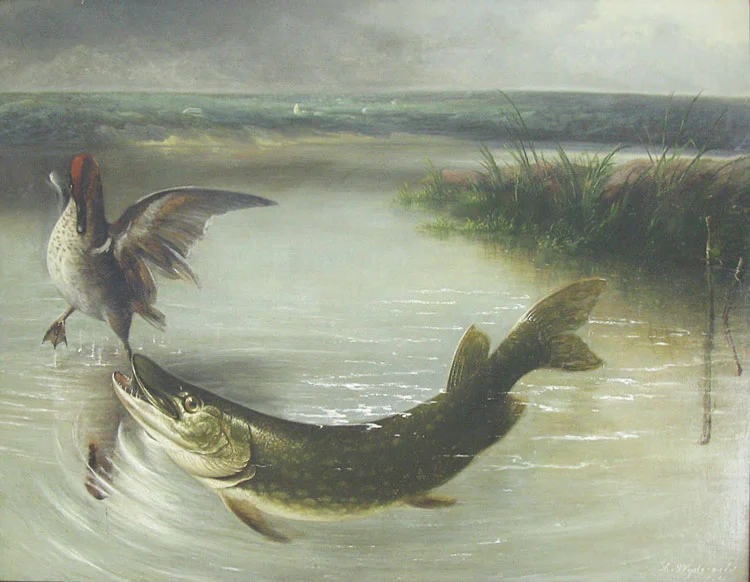"The Fighting Muskellunge" by Arnoud Wydeveld
This dramatic scene of natural predation depicts a Muskellunge (Esox masquinongy) capturing an adult Green-winged Teal (Anas carolinensis). The brass plate on the frame titles the painting “The Fighting Muskellunge” but more appropriate titles may have been “The Fighting Green-Winged Teal” or “The Predatory Muskellunge.” Although anyone who has ever had a Muskellunge on a line knows that it is indeed a fighter, in this portrayal it is the duck that is fighting for its life while the Muskellunge is about to enjoy easy pickings.
This circa 1875 oil on canvas is signed (lower right) “A. Wyderveld N.Y.” Arnoud Wydeveld (1883-1888) was a distinguished Dutch American artist who was born in Holland and immigrated to America in 1853 to join his brother who had settled in New York a few years earlier.
His original Dutch name was Arnoldus van Weydevelt, but in America he was known as Arnoud Wydeveld—although he exhibited at the National Academy in New York using several different spellings of his last name including Wydefield, Wydefeldt, and Wyderveld, which is how he signed this painting.
In America Wydeveld became known primarily for his luminous still-life portraits of flowers and fruit. He was influenced by the 17th- and 18th-century works of Dutch Old Master genre painters such as Johannes Vermeer, but his elegant paintings also incorporate elements of more contemporary mid-19th century European styles.
(from questroyal.com)
During his lifetime, Wyderveld's still-lifes were exhibited in prestigious galleries, such as the National Academy in New York, the Pennsylvania Academy of the Fine Arts, and the Brooklyn Art Association.
Fruit still-life painting by Wydeveld
In the 1870s, however, Wydeveld turned his attention to painting fish in their natural habitats. Whereas most of his flower and fruit still-lifes were portrayed on table-top settings, he sometimes depicted arrangements in outdoor settings, so he did have some inclination towards representing natural landscapes throughout his career.
Wydeveld also sometimes included fish and seafood as components of meals in his dining table tableaux, and also painted freshly caught fish, so he had previously portrayed fish from an edibles perspective.
Wydeveld fish painting
What inspired his transition towards painting lively fish in active scenes—artwork that fits within the sporting art rather than still-life genre—is not documented. One possibility is that he had taken up fishing himself and was thus inspired by observing the beauty of fish and their behaviors in their natural element.
Wydeveld fish painting
Wydeveld applied the skills he had honed during his years as a still-life painter to portraying fish in the wild, including an eye for detail and the ability to impart texture and a life-like presence in his painted depictions. This painting of a Muskellunge and Green-winged Teal is a masterful product of the artist's focus on fish during the 1870s.
Arnoud Wydeveld fish painting. Frame size: 34.5" h x 42.5" w; Sight size: 27.5" h x 35.5" w
The painting (seen from the back) has been relined and restretched for longevity.
Detail of the painting's period frame.
Clearly the star of this painting is the Muskellunge, affectionately known throughout its range as “muskie” (it is also the state fish of Wisconsin). Wydeveld depicted this muskie lurking in the bay of a large, horizonless lake, perhaps meant to represent one of the Great Lakes that it populates.
This muskie's dark coloration and spotted pattern are typical of Muskellunge found in the Great Lakes, while in other locations their skin can be more barred or clear.
Wydeveld accurately captures the muskie’s streamlined body, elongated snout, and far-back fin placement—an ideal physique for an “ambush predator.”
While muskies typically range from 2.5’-4’ in length, the largest can be over 6’ long and weigh over 70 lbs. Muskies eat all species of fish present in their habitats (including smaller individuals of their own species), as well as muskrats, frogs, and yes, ducks.
A muskie showing a lighter coloration more typical of those living in turbid waters. (from muskiesinc.org)
A Muskellunge cruising for food (atoztheusa.blogspot.com/2013/03/wisconsin-state-fish.html)
Jeff with a muskie he caught from a canoe while on a wilderness trip in Ontario years ago.
Although muskies have large stomachs that enable them to eat prey up to two-thirds their own body length, the Green-winged Teal is a very small duck—12"-15” long and weighing just 5-17 ounces—so it is more a snack than a meal for a large muskie.
A Green-winged Teal taking wing (brianzwiebelphotography.com)
Wydeveld captured the cinnamon color of the bird's head feathers, its dark green eyebands, and the spotting on its buff-colored breast.
As beautiful as Wydeveld’s floral and fruit still-life paintings are, we much prefer his spirited portrayals of fish in the wild. “The Fighting Muskellunge” is among the largest and most dynamic fish paintings Wydeveld created. Its presence will enliven a home with the energetic pulse and implicit story of fate and survival in the natural world.























